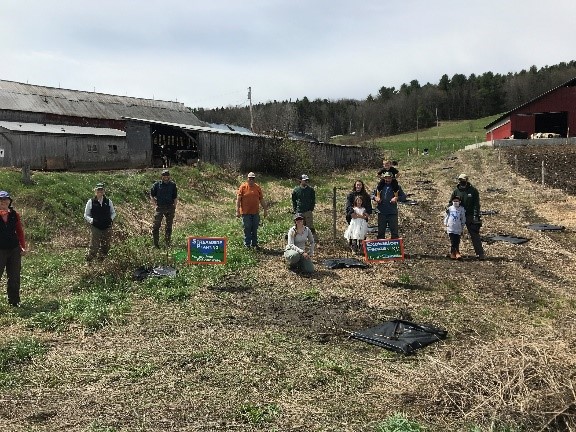By Orleans County Natural Resources Conservation District (NRCD)
Orleans County NRCD and its partners strive to work with farmers to improve farm management practices and water quality using Best Management Practices (BMPs) in the Lake Memphremagog Watershed, a lake that exceeds phosphorus water quality standards by 26 percent. A land use export model developed by the Vermont Department of Environmental Conservation and partners in Quebec identified agriculture as a major contributor to phosphorus in this watershed.
Considering the area’s water quality challenges, the Jones Family Farm of Craftsbury, located within the Black River Watershed, partnered with Orleans County NRCD in 2016 to seek regulatory compliance and a reduction of nonpoint source pollutants into the river.
By identifying farm goals and objectives, assessing the natural resources, prioritizing soil and water quality projects, and participating in the Orleans County NRCD water quality monitoring program, the Jones family hoped to comply with Vermont’s newly enacted Required Agricultural Practices (RAPs).
The farm’s conservation efforts included an RAP-compliant Nutrient Management Plan, new heifer manure storage and barnyard, increased vegetative buffer along a stream, livestock exclusion fencing, cover crop and no-till practices, and three years of water quality monitoring below and above the stream. Together, these practices have been shown to abet reduction of runoff and improve soil health and water quality.
Jim Jones, who manages the farm with his daughter Nicole, has found that “there is a lot of added unknown benefit to the projects. Like the new manure storage has made it easier for rounding up and handling cattle.” He believes compliance and implementation of conservation practices will help the farm in the future. “This work has added value to the farm and will help the next generation in the long run,” he said.
A consistency in water quality data throughout the three years of sampling showed that conservation practices were effectively reducing non-point source pollution. With this success, efforts shifted to the heifer manure storage and barnyard project work area. While this project fell outside of the sampling site, these best management practices have long produced phosphorus reduction and are a big step toward improving the Black River Watershed’s overall health.
For Jim, participating in the water sampling program was a little scary at first, but Jones concluded that “if it is bad, I want to know and I want do something about it. I knew that NRCD and NRCS conservation planners are here to help and work together to fix it. Orleans County NRCD staff stuck with us through the planning and implementing projects, they keep coming back, and have the willingness to listen to what we want and tweak things to make it work for us and for conservation."
Click here to read the full story.


